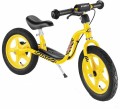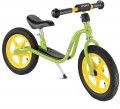—
Steel. A fairly common material, widely used in all types of children's bicycles (see "Type"). Although inexpensive, steel is very durable, reliable, and resistant to impacts and shocks. Many consider its main drawback to be its relatively large weight; however, the difference in weight with the same aluminum is usually not that great (especially compared to the weight of the cyclist). It is worth noting that different grades of steel can be used in children's bicycles, and the overall quality of this material often depends on the price category of the machine.
—
Aluminum. Aluminum-based alloys are very strong, weigh little, and are also much less susceptible to corrosion than steel. On the other hand, the cost of such materials is significantly higher, and high strength is not always critical (considering the peculiarities of riding children's bicycles, especially three-wheeled ones). Therefore, aluminum is less common, although it can also be used in all types of machines.
—
Plastic. Plastic is relatively light in weight, completely insensitive to moisture and easy to process — it can be given almost any shape and color. At the same time, this material is inexpensive. On the other hand, plastic is not durable; therefore, it is used exclusively in bicycles for the smallest, mainly in three-wheeled models and balance bikes (see "Type").
—
...href="/list/604/pr-9552/">Wood. The general characteristics of wood are such that this material is poorly suited for classic bicycles — both two- and three-wheeled — but is very convenient for balance bikes (see "Type"). Wood, even unpainted, looks good, and this material is quite pleasant to the touch. Its disadvantages include some fragility — while the same plastic is likely to bend from a strong impact, wood can crack. However, it is still difficult to damage a wooden balance bike frame. But such a product does not tolerate moisture well, so it should be stored in a dry place.
— Fiberglass. As a rule, in this case it is not pure fiberglass that is meant, but fiberglass — a composite material made of glass fiber filled with plastic filler. This material is noticeably stronger than regular plastic, but it is also more expensive, and in terms of overall reliability it still does not reach the level of steel and aluminum. Therefore, fiberglass frames are quite rare, and mainly among balance bikes (see "Type").
— Magnesium. Magnesium alloys are similar to the aluminum alloys described above: they are highly durable and lightweight. At the same time, compared to aluminum, this alloy is stronger and more durable, weighs more, but not much, but costs significantly more — and the difference in price rarely outweighs the advantages mentioned. As a result, magnesium frames are not very widespread; they are found only in certain models of two-wheeled bicycles of the older age group.—
Pedal. A variant used mainly in two-wheeled models (see "Type"). To brake, you need to press the pedals in the opposite direction; the braking itself is provided by the pads inside the rear hub. Pedal brakes are simple, inexpensive, do not require maintenance and are quite reliable, which is why they are extremely popular in children's bicycles. Their main disadvantage is that if the chain falls off, the bicycle loses the rear brake; however, the probability of this is not so high that this moment is critical.
— Rim mechanical. A brake in the form of a pair of pads, which are pressed against the wheel rim by pressing the handle (
manual type of brake); the force from the handle is transmitted by mechanical traction in the form of a cable (hence the name). Such brakes, unlike the pedal brakes described above, work even with a chain that has come off. At the same time, they are more complex, more expensive and require periodic maintenance, which is why they are rare, mainly in fairly advanced models of the older age category.
—
Disc. A brake in the form of a pair of pads, which, when pressed on the handle, are pressed against a special disk fixed on the wheel hub. The force from the handle to the pads is transmitted through mechanical traction, as in rim mechanical ones. However, disc brakes are considered more advanced — they are more powerful, more e
...fficient, and less sensitive to dirt and rim curvature. On the other hand, such systems are more complex and more expensive than rim ones, which is why they are used extremely rarely — mainly in high-end two-wheeled bicycles of the older age category.
— Trigger sleeve. A type of brake that combines the features of the two types described above: the pads are located inside the drum in the rear sleeve (like in pedal brakes), but the braking force is transmitted to them not from the pedals via a chain, but from the handle on the steering wheel via a cable (like in rim mechanical brakes). Due to this, such brakes can be installed on balance bikes (see "Type"), where pedals are absent by definition; in fact, trigger sleeve systems were created specifically for balance bikes.
— Pedal and rim. Bicycles equipped with both a pedal and rim rear brake. For more information on each of these types, see above; and their combination is used to increase the efficiency and safety of braking. Thus, a bicycle with such equipment is not afraid of a chain falling off: the pedal brake will fail, but the rim brake will remain functional. And the simultaneous use of two brakes can be useful for an emergency stop. On the other hand, such a combination significantly affects the price of the bicycle, despite the fact that in practice it is not needed so often. Therefore, this option has not become very widespread.
— Handbrake. A type of brake used exclusively on tricycles. It looks like a lever, usually mounted to the side of the seat; when this lever is raised, special stoppers are lowered onto the rear wheels. Note that tricycles are not designed for high speeds, and to brake, it is often enough to slow down the movement of the feet on the pedals. In light of this, the handbrake is provided more for “just in case” than for regular use; in some models, it can be used as a parking brake.
— Parental. A variant used in the youngest age group of tricycles, equipped with a parental handle (see below). As the name suggests, in such models the brake is controlled by the parent leading the bicycle — for example, by pressing a special lever on the parental handle.
